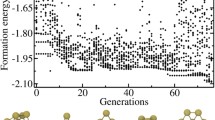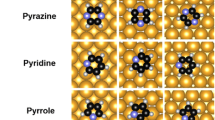Abstract.
Theoretical and experimental information on the shape and morphology of bare and passivated gold clusters is fundamental to predict and understand their electronic, optical, and other physical and chemical properties. An effective theoretical approach to determine the lowest-energy configuration (global minimum) and the structures of low energy isomers (local minima) of clusters is to combine genetic algorithms and many-body potentials (to perform global structural optimizations), and first-principles density functional theory (to confirm the stability and energy ordering of the local minima). The main trend emerging from structural optimizations of bare Au clusters in the size range of 12-212 atoms indicates that many topologically interesting low-symmetry, disordered structures exist with energy near or below the lowest-energy ordered isomer. For example, chiral structures have been obtained as the lowest-energy isomers of bare Au28 and Au55 clusters, whereas in the size-range of 75-212 atoms, defective Marks decahedral structures are nearly degenerate in energy with the ordered symmetrical isomers. For methylthiol-passivated gold nanoclusters [Au28(SCH3)16 and Au38(SCH3)24], density functional structural relaxations have shown that the ligands are not only playing the role of passivating molecules, but their effect is strong enough to distort the metal cluster structure. In this work, a theoretical approach to characterize and quantify chirality in clusters, based on the Hausdorff chirality measure, is described. After calculating the index of chirality in bare and passivated gold clusters, it is found that the thiol monolayer induces or increases the degree of chirality of the metallic core. We also report simulated high-resolution transmission electron microscopy (HRTEM) images which show that defects in decahedral gold nanoclusters, with size between 1-2 nm, can be detected using currently available experimental HRTEM techniques.
Similar content being viewed by others
Author information
Authors and Affiliations
Corresponding author
Rights and permissions
About this article
Cite this article
Garzón, I.L., Beltrán, M.R., González, G. et al. Chirality, defects, and disorder in gold clusters. Eur. Phys. J. D 24, 105–109 (2003). https://doi.org/10.1140/epjd/e2003-00187-4
Received:
Published:
Issue Date:
DOI: https://doi.org/10.1140/epjd/e2003-00187-4




